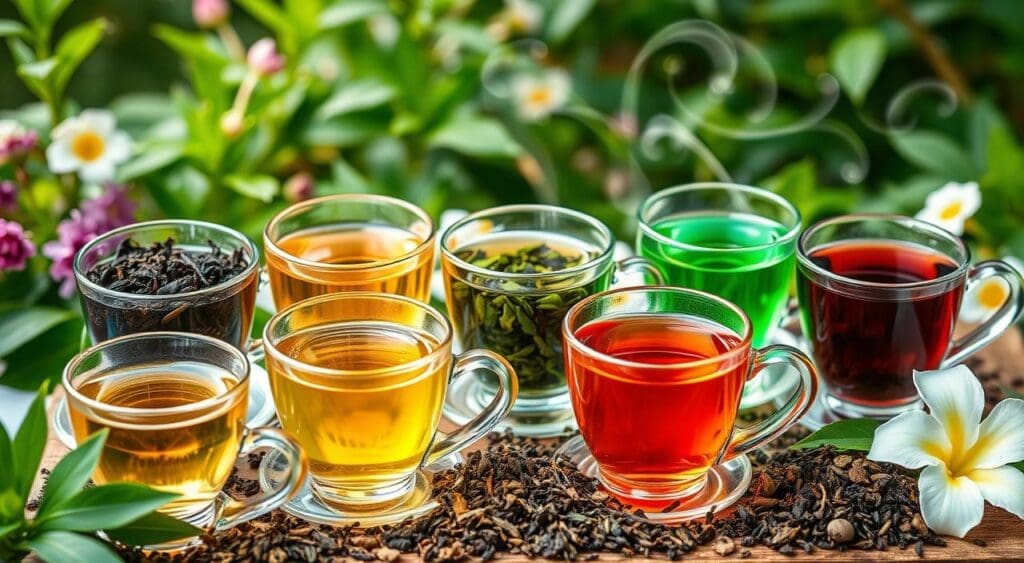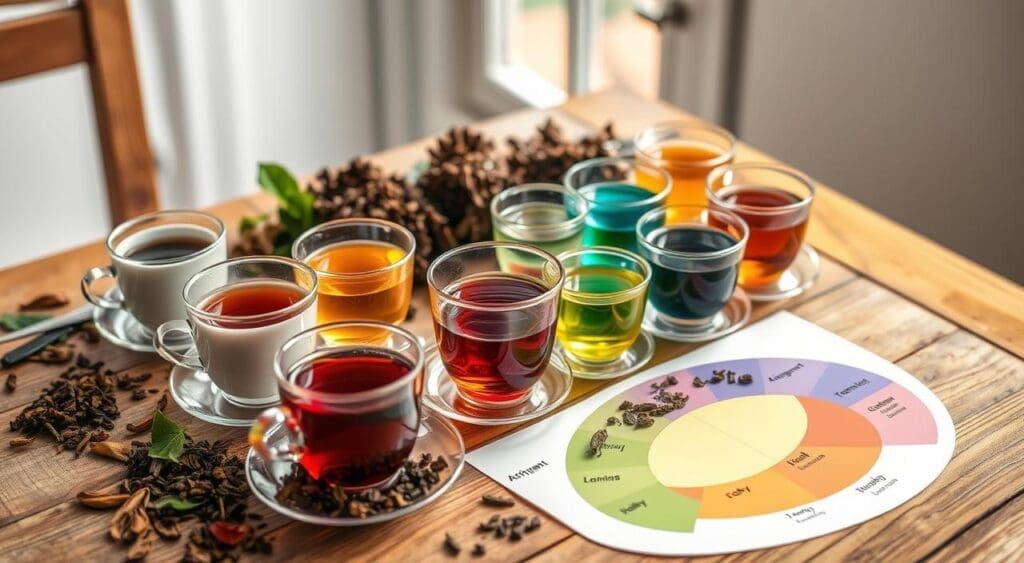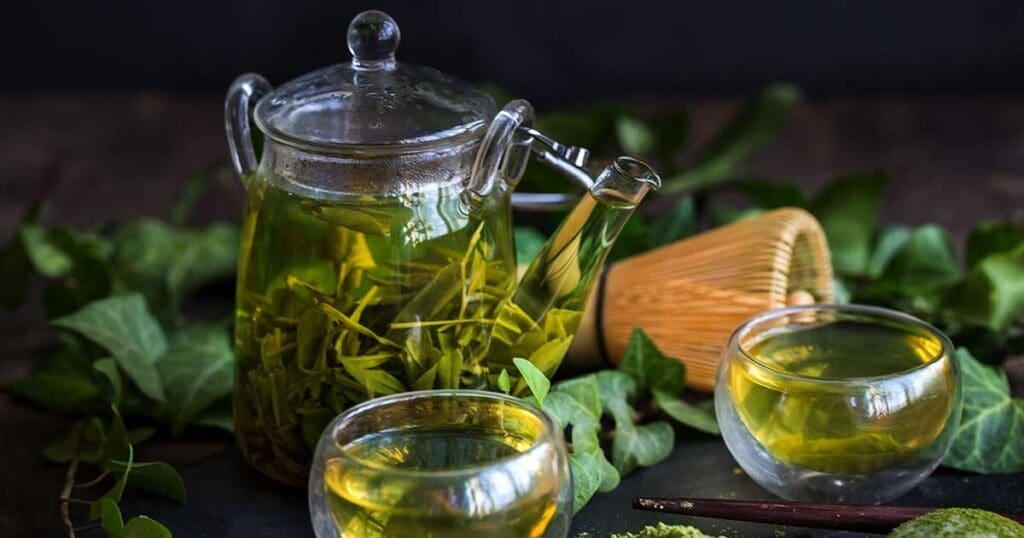Welcome to the world of tea tasting. It's a journey that reveals the secrets of this ancient practice. As a beginner, it's key to start with the basics. We'll guide you through the art of tea tasting and how to enjoy different flavors and aromas.
In this guide, we'll cover everything from tea ceremonies to brewing the perfect cup. Whether you're starting a new hobby or just want to enjoy tea, we've got you covered. Our expert tips will help you become a tea connoisseur. Let's start your journey in A Beginner's Guide to Tea Tasting together.
Key Takeaways
- Start with the basics of tea tasting to appreciate the different flavors and aromas
- Understand the cultural significance of tea ceremonies and their importance in tea tasting
- Learn how to brew the perfect cup of tea with our expert tea tasting tips
- Discover the essential tools and techniques needed to become a tea connoisseur
- Explore the world of tea and learn how to taste tea like a pro with our comprehensive guide
- Get ready to unlock the secrets of tea tasting and become a tea expert with our guide
- Learn the best practices for A Beginner's Guide to Tea Tasting and how to taste tea
Understanding the Art of Tea Tasting
Exploring the world of tea means more than just drinking it. It's about enjoying the flavors, aromas, and textures. By learning tea tasting techniques, we can better appreciate the variety of tea flavor profiles out there.
A beginner tea tasting guide begins with the basics. It covers the different types of tea, the importance of water quality, and how temperature affects brewing. We'll also learn about the cultural importance of tea ceremonies and how different cultures celebrate tea.
Key aspects of tea tasting include:
- Visual assessment: looking at the tea's color and appearance
- Aroma evaluation: enjoying the tea's scent and fragrance
- Taste profile analysis: exploring the tea's flavors and nuances
By following these steps and practicing tea tasting techniques, we can become more discerning tea drinkers. We'll appreciate the complexity and richness of tea flavor profiles. Whether using a beginner tea tasting guide or exploring on our own, the journey is rewarding and delicious.
Essential Tools for Your Tea Tasting Journey
Starting our tea tasting journey means having the right tools. Knowing tea tasting vocabulary is key to describing flavors and aromas. The tea grading scale helps us understand the quality and traits of teas.
To begin, we need a few basic items. These include a tea infuser, a teapot, and cups. Here's what to look for:
- Tea infuser: for steeping loose-leaf tea
- Teapot: for brewing and serving tea
- Cups: for tasting and appreciating the tea
As we dive into tea, learning about tea tasting vocabulary and the tea grading scale is crucial. These tools help us understand tea's complexity and appreciate its subtleties.
With the right tools and knowledge of tea tasting vocabulary and the tea grading scale, we're on our way to becoming tea experts. Through practice and patience, we'll grow to love the art of tea tasting. We'll also be able to share our newfound knowledge with others.
| Tool | Description |
|---|---|
| Tea Infuser | For steeping loose-leaf tea |
| Teapot | For brewing and serving tea |
| Cups | For tasting and appreciating the tea |
The Five Senses in A Beginner's Guide to Tea Tasting
Tea tasting involves all five senses. We use them to enjoy the unique qualities of each tea. This includes looking at the tea leaves, smelling the aroma, and tasting the flavors. Tea sommelier training helps us improve these skills and write detailed tasting notes.
As we dive into tea tasting, we notice the differences in tea leaves and brewed tea. Aroma evaluation techniques help us enjoy the scents and fragrances. Taste profile analysis lets us identify the flavors and notes. The tea's texture and mouthfeel also add to our experience.
Some key aspects of tea tasting include:
- Visual assessment: looking at the color and appearance of the tea leaves and the brewed tea
- Aroma evaluation: appreciating the different scents and fragrances of tea
- Taste profile analysis: identifying the various flavors and notes in the tea
- Texture and mouthfeel: the sensation of the tea in our mouth
By improving in these areas, we can enjoy tea tasting more. Whether we're beginners or want to get better, tea sommelier training helps. It gives us the knowledge to fully appreciate tea.
| Tea Type | Visual Assessment | Aroma Evaluation | Taste Profile |
|---|---|---|---|
| Black Tea | Dark brown or black leaves | Rich, malty aroma | Strong, full-bodied flavor |
| Green Tea | Light green or yellow leaves | Light, grassy aroma | Delicate, refreshing flavor |
Different Types of Tea and Their Unique Characteristics
Exploring the world of tea, we find many flavors to enjoy. For beginners, knowing the main tea types is key. These include white, green, oolong, black, and pu-erh. Each has its own taste, from green tea's floral notes to black tea's strong flavor.
Let's look at the main tea types:
- White tea: known for its light, delicate flavor and minimal processing
- Green tea: famous for its grassy, vegetal notes and high antioxidant content
- Oolong tea: partially fermented, offering a complex and smooth flavor profile
- Black tea: fully fermented, with a strong, rich flavor and dark color
- Pu-erh tea: fermented, with a earthy, mellow flavor and potential health benefits
Knowing these tea types is vital for beginners. It helps us enjoy each tea's unique taste. With this knowledge, we can start our tea adventure. We can try different brewing methods and flavors to find our favorite tea.

Proper Tea Preparation Methods
Learning how to taste tea starts with the right preparation. We need to think about water temperature, steeping time, and the right amount of tea. These tea tasting techniques help us make the perfect cup every time.
Knowing how to prepare tea is key to a great tea tasting experience. Whether you love tea or are just starting, understanding different methods is important. It lets us enjoy the special qualities of each tea.
Water Temperature Guidelines
Water temperature is very important in making tea. The best temperature changes with the tea type, usually between 160°F and 200°F. If the water is too hot or cold, it can mess up the tea's taste and smell.
Steeping Time Recommendations
Steeping time is also crucial. It can range from 1 to 5 minutes, depending on the tea and what you like. Steeping it just right lets the tea's flavors and smells come out perfectly.
Measuring Perfect Portions
Getting the right amount of tea leaves and water is key. It makes sure the tea is the right strength and taste. By following these tips and mastering the tea tasting techniques, we can always have a great cup of tea. It makes our how to taste tea journey even better.
Developing Your Tea Palate
Exploring the world of tea is a journey that needs patience, dedication, and practice. With the right tea tasting tips, we can improve our senses and become skilled tea tasters. This section will guide you on how to develop your tea palate, offering insights and techniques to enhance your tea tasting experience.
A Beginner's Guide to Tea Tasting highlights the importance of taste and flavor profile analysis. To develop your tea palate, start by tasting different teas. Note their unique characteristics and the subtle nuances that make them special. Here are steps to help you on your tea tasting journey:
- Start with a clean palate, free from any strong flavors or aromas
- Choose a variety of teas to taste, including black, green, white, and herbal options
- Pay attention to the color, aroma, and texture of each tea
- Take small sips, allowing the tea to linger on your palate
- Record your observations, noting the flavors, aromas, and textures you experience
By following these steps and practicing regularly, you'll start to develop your tea palate. You'll become more discerning and appreciate the complex flavors and aromas of tea. Remember, the key is to be patient, persistent, and open to new experiences. With time and practice, you'll become a skilled tea taster, enjoying the rich flavors and aromas of tea.
Understanding Tea Quality Grades
Exploring the world of tea means learning about the tea grading scale. This scale helps us see the differences in tea types and their qualities. Tea sommelier training offers insights into these grading systems, helping us choose the right tea.
The tea grading scale shows more than just the quality of the leaves. It also tells us about the tea's production, taste, and smell. Let's look at the main categories:
Commercial Grade Standards
Commercial grade teas are common and affordable. They are made in large quantities and might not have the special qualities of higher-grade teas.
Premium Tea Indicators
Premium teas are of higher quality and made with care. They use rare leaves, chosen and processed to enhance their flavors and scents.
Specialty Tea Classifications
Specialty teas are the rarest and most unique. They are made in small amounts and are loved for their special tastes and smells.
Knowing the tea grading scale helps us enjoy tea more. Whether we're learning to be tea sommeliers or just love tea, understanding this scale makes exploring tea more fun and rewarding.
| Grade | Description |
|---|---|
| Commercial | Mass-produced, affordable tea |
| Premium | High-quality tea with unique characteristics |
| Specialty | Exclusive, limited-production tea with distinct flavor profiles |
Common Tea Tasting Terms and Vocabulary
Exploring tea tasting means learning special words. A beginner guide should teach us about "astringent," "floral," and "umami." These terms help us talk about tea's tastes and smells.
Knowing tea tasting words is key to enjoying different teas. For example, "astringent" tells us about a tea's dry feel. "Floral" notes remind us of a garden. As we learn, we'll find many terms to share our tea experiences.
Some common terms include:
- Astringent: a drying sensation in the mouth
- Floral: delicate, flower-like flavors
- Umami: savory, rich flavors
- Bitter: a sharp, unpleasant taste
- Sweet: a pleasant, sugary taste
Understanding these terms helps us enjoy tea's complexity. Whether starting or improving, knowing tea terms is crucial. 
As we explore, we'll learn more terms. This knowledge will make us better at tasting tea. By following a guide and practicing, we'll discover new flavors and smells. This will make our lives richer and broaden our views.
Advanced Tasting Techniques
Exploring the world of tea requires improving our tasting skills. For those aiming for tea sommelier training, mastering advanced techniques is key. These methods deepen our tea appreciation and improve our tasting journey.
Creating detailed tasting notes for tea is a crucial skill. It involves focusing on the tea's flavor, aroma, and texture. This way, we can grasp the unique qualities of different teas and choose wisely.
- Professional cupping methods, which involve evaluating the tea's flavor and aroma in a controlled environment
- Flavor profile mapping, which helps to identify the unique characteristics of a particular tea
- Comparative tasting sessions, which allow us to compare and contrast different teas side by side
Using these techniques in our tea tasting routine enriches our understanding of tea. Whether we're on the path to tea sommelier training or just want to enjoy tea more, these methods are vital for tea lovers.
Building Your Tea Collection
Exploring the world of tea can be exciting. Building a personal tea collection is a fun journey. In A Beginner's Guide to Tea Tasting, we learn about different tea flavors. This knowledge helps us create a diverse and thrilling collection.
We start by picking teas from various places and types. This includes black, green, and herbal teas. When choosing, think about the aroma, taste, and how it feels in your mouth. Tea flavor profiles can be floral, fruity, earthy, or nutty.
Trying different ways to brew tea can also reveal each tea's unique qualities. This makes our collection even more special.
To keep our teas fresh, we use airtight containers. Here are some tips for building and caring for our collection:
- Choose teas from reputable sources
- Store teas in a cool, dry place
- Experiment with different brewing methods
By following these tips and learning about tea flavors, we can build a diverse and enjoyable collection. Whether you're new to tea or already love it, A Beginner's Guide to Tea Tasting is a great starting point. It helps us explore the world of tea and create a collection that's all our own.
Recording and Sharing Your Tea Experiences
Exploring the world of tea is exciting. We want to share our adventures and learn from others. Recording and sharing our tea experiences helps us find patterns and connect with tea lovers. It also makes our tea tasting journey better.
Tea tasting needs a systematic approach. We can create tasting notes, use digital journals, and join tea communities. These methods help us improve our tea skills and share our love for tea.
Creating Tasting Notes
Writing tasting notes is key in tea tasting. It lets us record our thoughts on the tea's aroma, flavor, and texture. This way, we can track our progress and get better at tasting tea.
To start, we can use a simple template. It should include the tea's name, where it's from, and how it's brewed. Then, we can note our thoughts on its aroma, flavor, and texture.
Digital Tea Journals
Digital tea journals are great for keeping our notes organized. They let us easily find and compare our notes. We can also share them with others.
There are many digital tea journal options out there. Tea tasting apps and online tea communities are popular. These tools help us connect with other tea lovers, learn from them, and share our own tea knowledge.
Social Tea Communities
Social tea communities are perfect for connecting with tea fans. They offer a space to share our notes, ask questions, and learn from others. Online forums, social media groups, and tea blogs are great places to join.
Being part of these communities lets us discover new tea tasting tips. We can find new teas and make our tea tasting experience even better.
| Tea Type | Aroma | Flavor | Texture |
|---|---|---|---|
| Green Tea | Grassy | Light | Smooth |
| Black Tea | Earthy | Rich | Full-bodied |
Conclusion: Your Journey into the World of Tea
This guide has shown you the vast world of tea. It's full of possibilities for fun and learning. Whether you want to become a tea sommelier or just enjoy your favorite teas, you now have a good start.
Tea tasting is a lifelong journey. There's always more to learn and try. Expand your taste, try new teas, and meet others who love tea as much as you do. This will help you appreciate tea even more.
Keep being curious and exploring. The tea world welcomes you with open arms. You'll find lots of help and resources. Enjoy every sip, the ritual, and let tea take you on a journey of taste and smell.
Disclaimer:
Some of the links on this site are affiliate links, which means I may earn a small commission if you make a purchase through them, at no additional cost to you. Thank you for supporting Brew Sip Repeat!




Facebook Comments